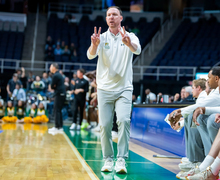SU autonomous systems institute to research impacts of drones
Daily Orange File Photo
In August, Gov. Andrew Cuomo announced $5 million in investments to manage a drone corridor from Syracuse to Rome.
Before drones can deliver fast food or Amazon packages, Syracuse University’s Autonomous Systems Policy Institute aims to address lingering concerns that surround their deployment.
Jamie Winders, professor of geography, is leading SU’s efforts as director of the institute, which launched in May. The ASPI is dedicated to researching and addressing questions concerning the use and deployment of autonomous systems, which SU defines widely as an electronic system that can think independently.
“We’re seeing all of this really exciting technological innovation, but what we don’t yet have is sort of a clear policy framework to guide how these systems will be used,” Winders said.
Meanwhile, New York state is investing in what will soon be a drone corridor running from Syracuse to Rome. In August, Gov. Andrew Cuomo announced $5 million in investments to manage the corridor — with SU and Mohawk Valley Community College coordinating research, according to Empire State Development, an organization representing the state’s economic development.
Winders posed examples of issues the ASPI could study. If 50% of cars in New York City are driverless vehicles, and pedestrians are aware that the vehicles will stop if someone walks in front of them, traffic would come to a complete stand-still, she said. The ASPI could study, for example, whether walking in front of a self-driving vehicle should be illegal.
For all the data that these systems collect, there needs to be groups monitoring security and privacy concerns about who can own that data, Winders said.
“Will everybody’s mobility be enhanced?” she asked. “Will everybody reap the benefits of these systems, or will some communities carry more of a burden than a benefit?”
Finding solutions to these questions will be a long process, Winders said.
Winders’ hope is that students are drawn to SU because it provides them the opportunity to be a part of a developing field. For now, industries associated with autonomous systems are in their beginning stages, she said.
SU’s diverse array of colleges and schools is one of the reasons the university is interested in studying autonomous systems policy, Winders said.
“We really need all of those perspectives to get a comprehensive understanding of the impacts of these systems and then to start to figure out how we might create policy infrastructures and how we might regulate their use,” Winders said.
Autonomous systems and artificial intelligence are predicted to be a significant technological revolution, said John Liu, vice president for research.
Current policy related to these systems would require people with expertise in technology, as well as policy researchers, Liu said. Working together, individuals with expertise in technology and policy could accomplish what they would be unable to accomplish working separately.
“Take one technology person, one policy person; you each individually cannot do it,” Liu said. “Bring you all together as a team, now you can do it.”
The ASPI could be a strong partner with the Syracuse Surge, an initiative by Mayor Ben Walsh to reinvigorate the city’s economy through technology, Winders said.
Syracuse recently invested $38 million to replace the city’s street lights with LED-connected lighting, allowing the city to increase connectivity and access, Winders said. As investments in the city continue, such as the implementation of 5G internet from Verizon, questions will be raised about accessing that infrastructure, said Jennifer Tifft, deputy commissioner of the Department of Neighborhood and Business Development, said.
Tifft said Syracuse is being thought of as a “sandbox” for digital technology because of the Syracuse Surge.
“If we’re creating a sandbox for the digital technology, we can also create the sandbox for the policy too,” Tifft said. “If we’re trying to test policy principles or pilot something under a certain policy framework, we can see how that actually works, and then we can adjust it accordingly.”
SU’s focus on the policy of autonomous systems is a critical component of developing the new economy, Tifft said. There are potentially great benefits to use autonomous systems, but the choices regarding their deployment and introduction into public use need to be thought through, Tifft said.
“This new economy is coming,” Tifft said. “There are going to be a lot of questions that people have, potentially fears that people have and concerns about a drone overhead or an autonomous vehicle on the street.”
Published on September 3, 2019 at 10:08 pm
Contact Emma: esfolts@syr.edu





